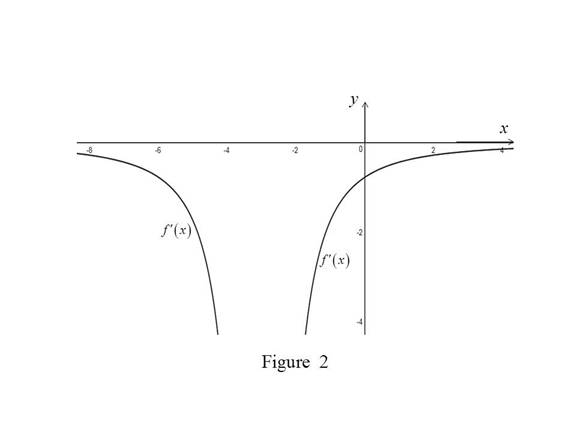
(a)
To find: The asymptotes of the graph of
(a)
Answer to Problem 38RE
The vertical asymptote is
Explanation of Solution
Calculation:
Recall that the line
Take limit on the above.
Thus, the horizontal asymptote is
Recall that the line
Thus, the vertical asymptote is
Graph:
Use the above information and trace the graph of

Observation:
(b)
To sketch: The graph of
(b)
Explanation of Solution
Calculation:
From the above graph in part a,
it is cleared that
Both the two disjoint curves of f have negative slope.
Thus, the graph of
For the curve present below the y-axis,
the value of the slope decreases as the curve moves from left to right
approaching the line
Thus, the graph of
For the curve present above the y-axis,
the value of the slope increases as the curve moves from left to right
approaching the line
Thus, the graph of
Graph:
Use the information above and trace the graph of

(c)
To find: The derivative of
(c)
Answer to Problem 38RE
The derivative is
Explanation of Solution
Formula used:
The derivative of a function f, denoted by
Calculation:
Obtain the derivative of the function
Compute
Simplify the numerator in the above expression
Since the limit h approaches zero but not equal to zero, cancel the common term h from both the numerator and the denominator,
Thus, the value of the derivative is
(d)
To sketch: The graph of
(d)
Explanation of Solution
Graph:
Use an online graphing calculator to sketch the graph of

Observation:
From Figure 3, it has been observed that
Comparison:
The function in Figure 3 seems to be the same graph which was sketched in part b.
Chapter 2 Solutions
Single Variable Calculus: Concepts and Contexts, Enhanced Edition
 Calculus: Early TranscendentalsCalculusISBN:9781285741550Author:James StewartPublisher:Cengage Learning
Calculus: Early TranscendentalsCalculusISBN:9781285741550Author:James StewartPublisher:Cengage Learning Thomas' Calculus (14th Edition)CalculusISBN:9780134438986Author:Joel R. Hass, Christopher E. Heil, Maurice D. WeirPublisher:PEARSON
Thomas' Calculus (14th Edition)CalculusISBN:9780134438986Author:Joel R. Hass, Christopher E. Heil, Maurice D. WeirPublisher:PEARSON Calculus: Early Transcendentals (3rd Edition)CalculusISBN:9780134763644Author:William L. Briggs, Lyle Cochran, Bernard Gillett, Eric SchulzPublisher:PEARSON
Calculus: Early Transcendentals (3rd Edition)CalculusISBN:9780134763644Author:William L. Briggs, Lyle Cochran, Bernard Gillett, Eric SchulzPublisher:PEARSON Calculus: Early TranscendentalsCalculusISBN:9781319050740Author:Jon Rogawski, Colin Adams, Robert FranzosaPublisher:W. H. Freeman
Calculus: Early TranscendentalsCalculusISBN:9781319050740Author:Jon Rogawski, Colin Adams, Robert FranzosaPublisher:W. H. Freeman
 Calculus: Early Transcendental FunctionsCalculusISBN:9781337552516Author:Ron Larson, Bruce H. EdwardsPublisher:Cengage Learning
Calculus: Early Transcendental FunctionsCalculusISBN:9781337552516Author:Ron Larson, Bruce H. EdwardsPublisher:Cengage Learning





